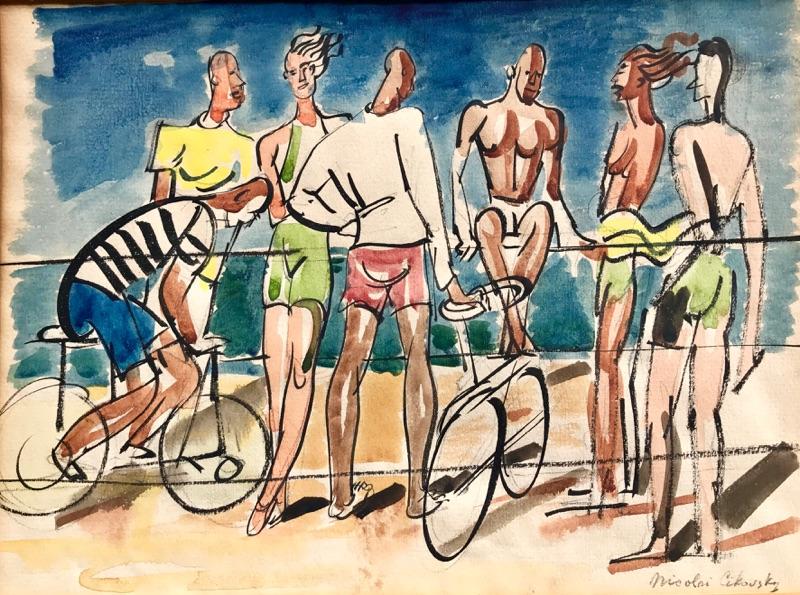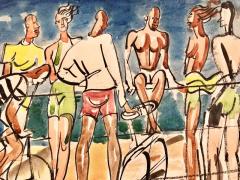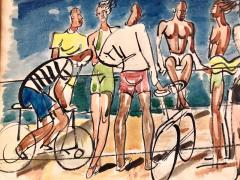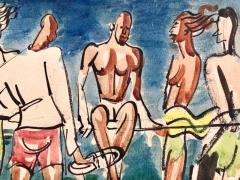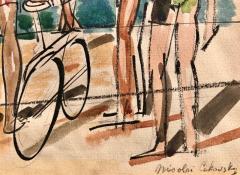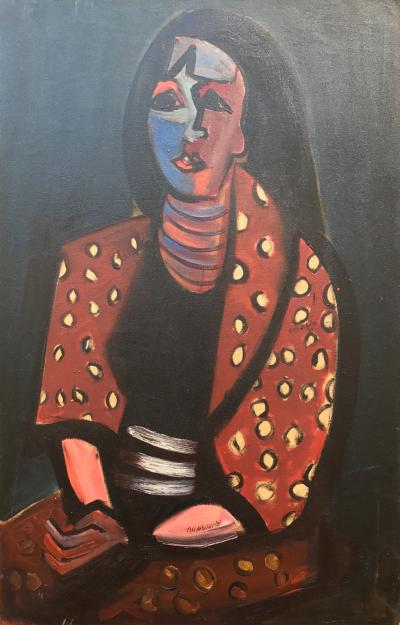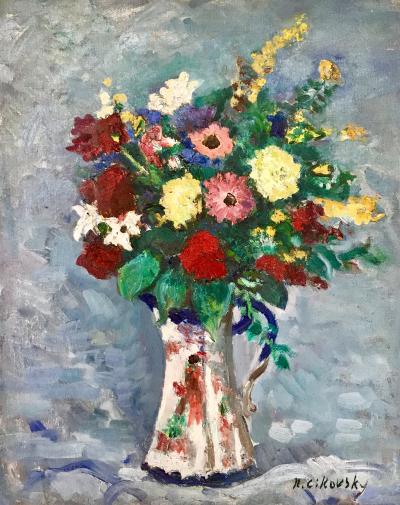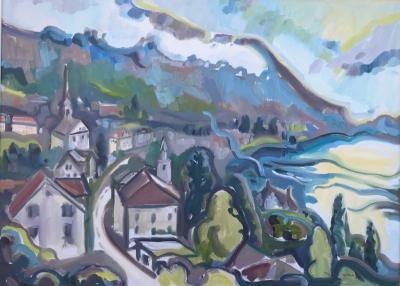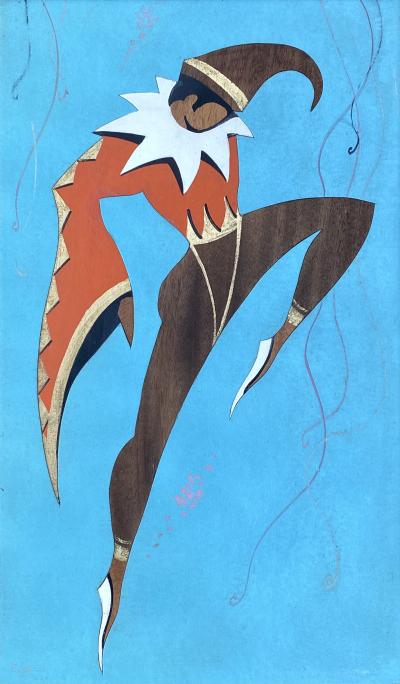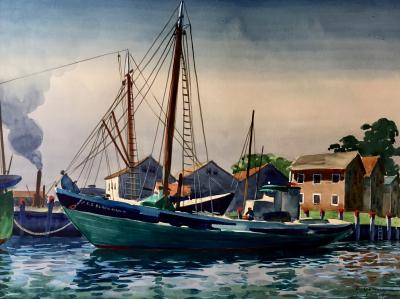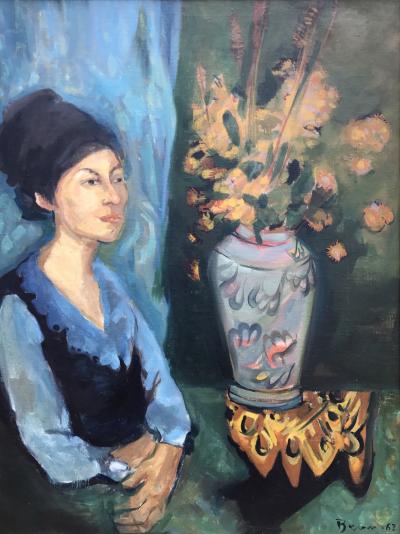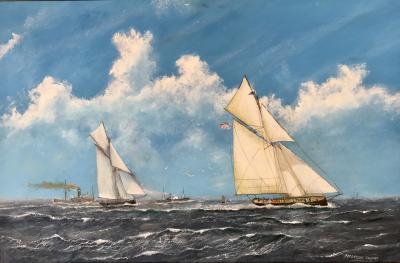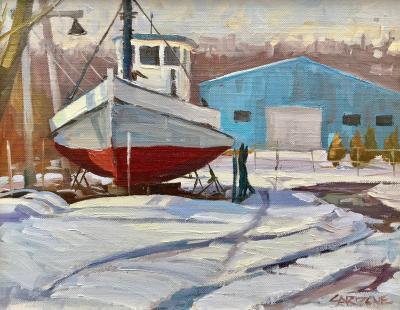“Gay Youngsters”
-
Description
Original watercolor with graphite underlying sketching by the American artist, Nicholas Cikovsky. Signed lower right. Condition is good. Titled verso. Circa 1950. Newly matted with its original bleached oak frame. 18 by 21 inches overall.
Nicolai Cikovsky, Russian/American (1894 - 1984)
Nicolai Cikovsky painted figure subjects, landscapes, portraits and still lifes, working in a simplified Realist manner that reflects his earlier exposure to modern European art. During the 1930s and 1940s, he was linked with American Scene painting and Social Realism in New York, creating works of art that were acclaimed for their strength, vitality and individuality of expression. Later in his career, his paintings took on a more lyrical note as he responded to the light, color and scenic beauty of eastern Long Island.
Cikovsky was born in Pinsk, Poland. The son of a fisherman and his wife, he was encouraged to paint and draw at an early age. He went on to receive his formal art training in Russia, studying at the Vilna Art School (1910-14), where Chaim Soutine was a fellow pupil, and at the Penza Royal Art School (1914-18), where he met the vanguard painter Vladimir Tatlin. Following this, Cikosvky attended classes under Favorsky and Mashkow at the Moscow Technical Institute of Art (1921-23), known for its promotion of progressive modes of painting. From 1919 until 1921 he was an instructor at the Ekaterinenburg Higher Technical Art Institute. During these years, Cikovsky’s painting style was influenced by avant-garde European art, ranging from the Post-Impressionism of Paul Cézanne and the Fauvism of Henri Matisse to styles such as Cubism, Futurism and Constructivism.
Seeking greater opportunities to sell and exhibit his work, Cikovsky immigrated to the United States in 1923, settling in New York; unfortunately, he had to leave all his early paintings behind. He initially supported himself by working as a theatrical designer and a commercial muralist, while painting in his spare time. In 1926, he exhibited one of his Cubo-Futurist paintings at Kathryn Dreier’s International Exhibition of Modern Art, held at the Brooklyn Museum. In 1930, Cikovsky had his first one-man show at the Daniel Gallery in New York and soon found a market for his paintings. It was around this time that he met the painter Raphael Soyer, also a Russian émigré. Influenced by Soyer’s example, Cikovsky began to explore Social Realism, a thematic interest that reflected his growing belief that “the future of American art will be more closely identified with the working class.” This attitude was also sparked by his affiliation with the John Reed Club, the Artists Union Congress and the American Artists Congress.
In addition to depicting aspects of daily life, especially in the vicinity of his East Fourteenth Street studio, Cikovsky also painted landscapes in Woodstock, New York and Massachusetts’s Cape Ann peninsula. During the 1940s, the artist spent five years in Washington, D.C., where he taught at the Corcoran School of Art. He also gave instruction at the Art Students League of New York, the St. Paul School of Art, the Cincinnati Art Academy, the College of Notre Dame in Maryland and the School of Art Institute of Chicago.
Cikovsky worked in an advanced Realist manner, emphasizing flat color areas, rich, vibrant color and lush surfaces textures; as one commentator put it: “he seems enamored of the possibility of pigment, which in his hands has a lush richness of substance that is in itself a sensuous delight, yet he maintains a fine balance between the modern and the traditional.”
In 1942, Cikovsky visited the North Sea area of Southampton, Long Island, at the invitation of the Russian-born painter David Burliuk. Attracted to the region, which had been a haven for artists since the late nineteenth century, he began spending his summers there, creating landscapes and beach scenes in oil, watercolor and tempera. He moved to Southampton permanently in the late 1970s, residing in a cottage on Wooley Pond. In his Long Island pictures, Cikovsky took a greater interest in color and light; as the aforementioned Soyer observed: “For me it was wonderful to watch Nick Cikovsky paint the white beaches, the ponds, the potato fields of Long Island. He loves moving clouds, shimmering sunlight on rippling water, and the multi-colored flowers in his own garden . . . If one could consider painting as poetry, then Nicolai Cikovsky may be called the poet of Long Island.” Not surprisingly, Cikovsky’s later work set an example for a number of Long Island painters, among them Jane Freilicher and Fairfield Porter.
Cikovsky was the recipient of numerous awards and prizes, including the Harris Bronze Medal (1931) and the Logan Purchase Prize (1932) at the Art Institute of Chicago, three bronze medals at the Washington (D.C.) Society of Artists and purchase prizes at the Worcester Art Museum and the National Academy of Design among many others. In addition to his activity as a painter, he worked as a printmaker and as a muralist, executing decorations for the Department of Interior Building in Washington, D.C. and for post offices in Towson and Silver Spring, Maryland.
Cikovsky died in Washington, D.C. Representative examples of his work can be found in important collections throughout the United States, including the Museum of Fine Arts, Boston; the Brooklyn Museum, Brooklyn, New York; the Art Institute of Chicago; Los Angeles County Museum of Art; the Metropolitan Museum of Art, New York; the Museum of Modern Art, New York; the Whitney Museum of American Art, New York; the Carnegie Museum of Art, Pittsburgh; and the Phillips Collection, Washington, D.C. - More Information
- Dimensions
Message from Seller:
Arthur T. Kalaher Fine Art, located in Southampton, NY, offers a curated selection of traditional and contemporary works, including pieces by the Peconic Bay Impressionists and the estate of Nahum Tschacbasov. For inquiries, contact 631.204.0383 or visit arthurkalaherfineart.com.
Sold
















